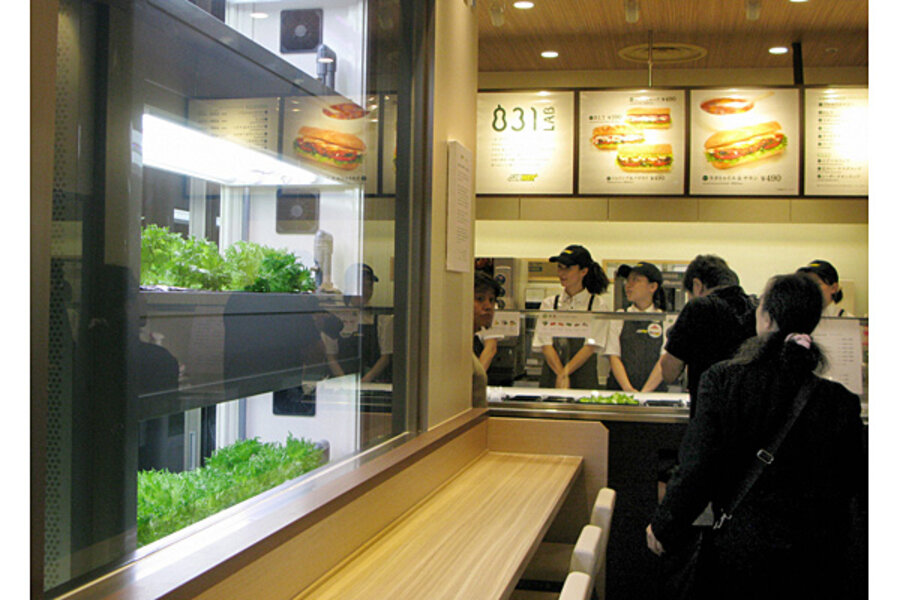How Subway wooed the Japanese lunch crowd
Loading...
| Tokyo
Japanese people produce less saliva than many Americans – and for Subway, the fast-food chain, that strange yet pertinent scientific fact made all the difference.
The chain's hard, crusty sandwich bread, produced overseas, was difficult for its Japanese clientele to chew and digest. So in 2011, Subway Japan started producing its own bread domestically, altering the recipe to make it softer and lighter than the bread used by Subway in other countries.
Changing the bread was one of several tweaks the American-based chain has had to make over the past two decades to become a major player in the Japanese fast-food market. As many other fast-food chains including McDonald's and KFC have learned, succeeding overseas means adjusting to the cultural and gastronomical leanings of other countries and junking whatever doesn't work, even if it's key to the brand back home.
Aside from the name, and the fact that they both sell sandwiches, Subway in Japan and Subway in the United States barely resemble each other.
"Subway first came to Japan about 20 years ago, and quickly expanded to 150 stores," says Masako Iwasaki, a spokeswoman for Subway Japan. "It did well initially, but the number of stores quickly dropped to 90" after the novelty wore off.
In an effort to turn things around, management took a three-pronged approach. On the economic end, it trimmed down the square footage of stores and set up more locations in food courts to mitigate the high cost of land in Japan. To improve efficiency (and cope with the tighter quarters), it scaled back on the amount of sandwich customization typically found in American Subway locations.
Second, management introduced a Japanese-only menu, cutting down on the number of sandwiches featuring deli meat. "The kind of hams used in Subway, customers didn't think it was special because they had them in the fridge," Ms. Iwasaki says. Japan-friendly sandwiches were introduced, including Chicken Teriyaki and Shrimp Avocado (now one of Subway Japan's most popular sandwiches).
Third, the chain got rid of the "Eat Fresh" slogan, which translated poorly to Japanese. "When we interviewed the successful 90 stores that survived and were making profit, they said customers come because they think they can get ample veggies," compared with other fast-food options, Iwasaki says. "So we went with that." A new slogan, loosely translated "Veggie Subway," was launched in 2008. The rebranding has worked wonders: Subway Japan has doubled the number of its locations over the past 2-1/2 years to around 460 locations nationwide.
In most cases, undergoing such a major marketing shift for an established brand can be risky and potentially disastrous. For example, JCPenney underwent a major rebranding effort to lure younger customers, only to alienate its loyal base and send company finances into free fall.
But Japanese consumers are widely considered among the most brand-loyal in the world, allowing entrenched companies to try new things without being quite so worried about scaring away clients. Fujifilm, for example, has found success selling over-the-counter medications and cosmetics after the fortunes of its film-camera business went south.
As a result, constant product tweaking is par for the course. McDonald's Japan, for example, recently dealt with its own version of the Subway bread issue, reformulating one of its popular chicken sandwiches. "With the Chicken Filet-O, our female customers were telling us that the crust [on the chicken] was too heavy, so we made it lighter," says Kenji Kaniya, a spokesman for McDonald's Japan in Tokyo.
Vegetables have become so central to Subway's image and marketing in Japan that many locations there feature miniature greenhouses in the dining areas where lettuce is grown, some of which is used in-house. A veggie focus may not work in most developed nations, Iwasaki says, but it fills an untapped need in the relatively young Japanese fast-food market, which is largely dominated by noodle shops and chains such as KFC and McDonald's. Subway's clientele skews between 80 and 90 percent female, and the majority of those are urbanites between ages 20 and 40.
"A lot of people come here to maintain their weight. A female office worker might think, 'I ate too much last night; I will go to Subway for lunch,' " Iwasaki says.
A focus on weight loss is one thing Subway Japan does have in common with its US counterpart, though a Japanese "Jared, the Subway Guy," has yet to emerge.
Reporting for this story was made possible through a fellowship with the Foreign Press Center of Japan (FPCJ).






